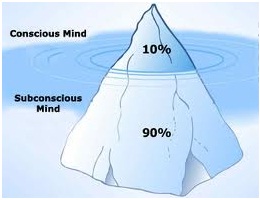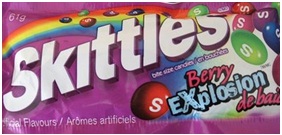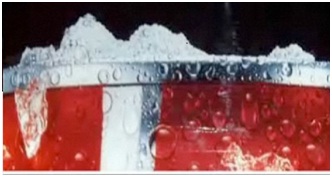- Articles ›
- Marketing and Strategy ›
- Subliminal Marketing - What You See You May Not See! Articles
Subliminal Marketing - What You See You May Not See!
“Subliminal Marketing” is a mode of promoting messages by stimulating unconscious mind of the recipient, without him/her even knowing about it. Subliminal advertising is a kind of marketing where a message is intentionally embedded within an image or sound. Many people might not be consciously aware about being exposed to such implications but will often change their actions and attitudes after viewing/ listening to the advertisement.

Our senses are constantly being bombarded with enormous amount of information, only a small percentage of data reaches our consciousness, however our subconscious mind absorbs almost everything.
Subconscious mind is fed the information and it absorbs like a sponge.

Today an average supermarket contains varied options of consumable items and billions are spent on advertising each year, with figures growing exponentially. To SEPARATE THE BEST FROM THE REST, advertisers have came up with this novice concept of subliminal marketing. It’s a technique of exposing the consumers to images of the product, brands, without the consumers being consciously aware of. Once the customers are exposed to such stimulus, the brain of the customer is believed to decode the information by itself and act upon it without the power to acknowledge a communication stimulus.
A successful subliminal advertisement is one that inconspicuously entices consumers to buy and use various products and services.
History
The history of its inception dates back to 1957 when message of “Drink Coca Cola” & “Eat popcorn” was superimposed on the movie in progress. The firm reported a dramatic increase in sales of both the items after this, though no written documentation was provided. While some newspapers of that time termed it as the NEXT BIG THING after invention of gun, others raised concerns over ethics of using such techniques to target unconscious part of the human brain. In some countries such as Canada and Australia there were trials and cases against use of subliminal advertising but since there was no scientific implication of such messages, thus the companies following such strategy, always had judgements in their favour.
What science says?
There are three identifiable means of subliminal simulation for which strong behavioural effects have been claimed.
- First involves very briefly visual stimuli presented fora very brief duration.
- Second is the use of accelerated speech in low volume auditory messages.
- Third is the embedded and hidden erotic imagery in print advertisements.
Limitation with presenting subliminal stimuli is to take into account the varied threshold level of each individual. In order to preclude detection by those with relatively low threshold level, the stimulus would have to be so weak that it would not reach viewers with high threshold level. Another constraint lies in the fact that integration of subliminal stimuli into ongoing supraliminal material is not an easy task because of the timing of the blank interval, before and after the supraliminal material. Too short interval will result in masking of subliminal message by supraliminal and too long interval will lead to subject inferring the presence of stimuli.
The various experiments and tests done by various scientists over the matter do not shed much light on the effects of subliminal stimuli. As per Timothy E Moore “The potential effects of subliminal stimuli are easily nullified by other ongoing stimulation in the same sensory channel, thus posing serious difficulties for any possible market application”. Also subliminal stimuli have shown some positive response towards the object rather than the particular brand. For example if burger of a company X is shown for a few milliseconds in theatres, then it may lead to increase in sales of burgers in general or even some other eatable and not that of brand X. Thus scientifically, subliminal advertising is not a proven method for marketing.
Counter Argument:
The greatest threat to subliminal messages is the threshold problem as mentioned above. The fact is that even if 1% of the target population receives the message in the intended way, then the whole exercise will be worthwhile. Also if the subliminal messages lead to growth in consumption of any type of article say cigarette, then the chances of the increase in sales of the interested brand of cigarette are very high. The recent chartbuster hit song “ Munni badnam hui” lead to increase in sales of “ JHANDU BALM” by 35%. In movies such as “Main hoon na” SRK was seen wearing ‘Levis’ apparel, eating at ‘Pizza Hut’, munching ‘Lays’, sipping coffee at ‘Cafe Coffee Day’ and rescuing Sushmita Sen from abductors who carry her in ‘Santro’. These are examples of semi subliminal message.
Samples of Subliminal Advertisements:
Look at the first picture to the left. The ball marked “S” has really skittled close to the word explosion. Is it just a co-incidence?

The picture of cola on the right seems innocuous at first glance, but a closer examination of top part of the can shows a naked girl lying on top of the can.

Now look at the picture below. There are companies out there whose job is to place ads inconspicuously. The arrow mark has been put for the convenience of readers to notice one such advertisement.

There are hundreds and thousands of such examples in contemporary times which point towards usage of Subliminal Advertising.
Conclusion:
Scientific world is still baffled with subliminal messages. All the information that is available showed inconsistency in experimental results and indirect correlations that didn’t necessarily prove if this type of marketing is successful. Scientifically messages that are flashed before a viewer’s eye do stimulate the brain and can result in the purchase of a product, but not always. Thus subliminal marketing comes down to a chance.
But the marketing firms have embraced this technology with open hands. The use of subliminal marketing is on an all time high owing to few successful results in the past. Also the issue of ethics is unresolved when it comes to use of this mode of marketing. Issues are plenty and no perfect solution has been offered so far, thus the contention goes on.
Whose side are you on???
This article has been authored by Abhishek Singh and Vipul Arun from IIM Rohtak.
Image: FreeDigitalPhotos.net
Views expressed in the article are personal. The articles are for educational & academic purpose only, and have been uploaded by the MBA Skool Team.
If you are interested in writing articles for us, Submit Here
Share this Page on:
What is MBA Skool?About Us
MBA Skool is a Knowledge Resource for Management Students, Aspirants & Professionals.
Business Courses
Quizzes & Skills
Quizzes test your expertise in business and Skill tests evaluate your management traits
All Business Sections
Write for Us